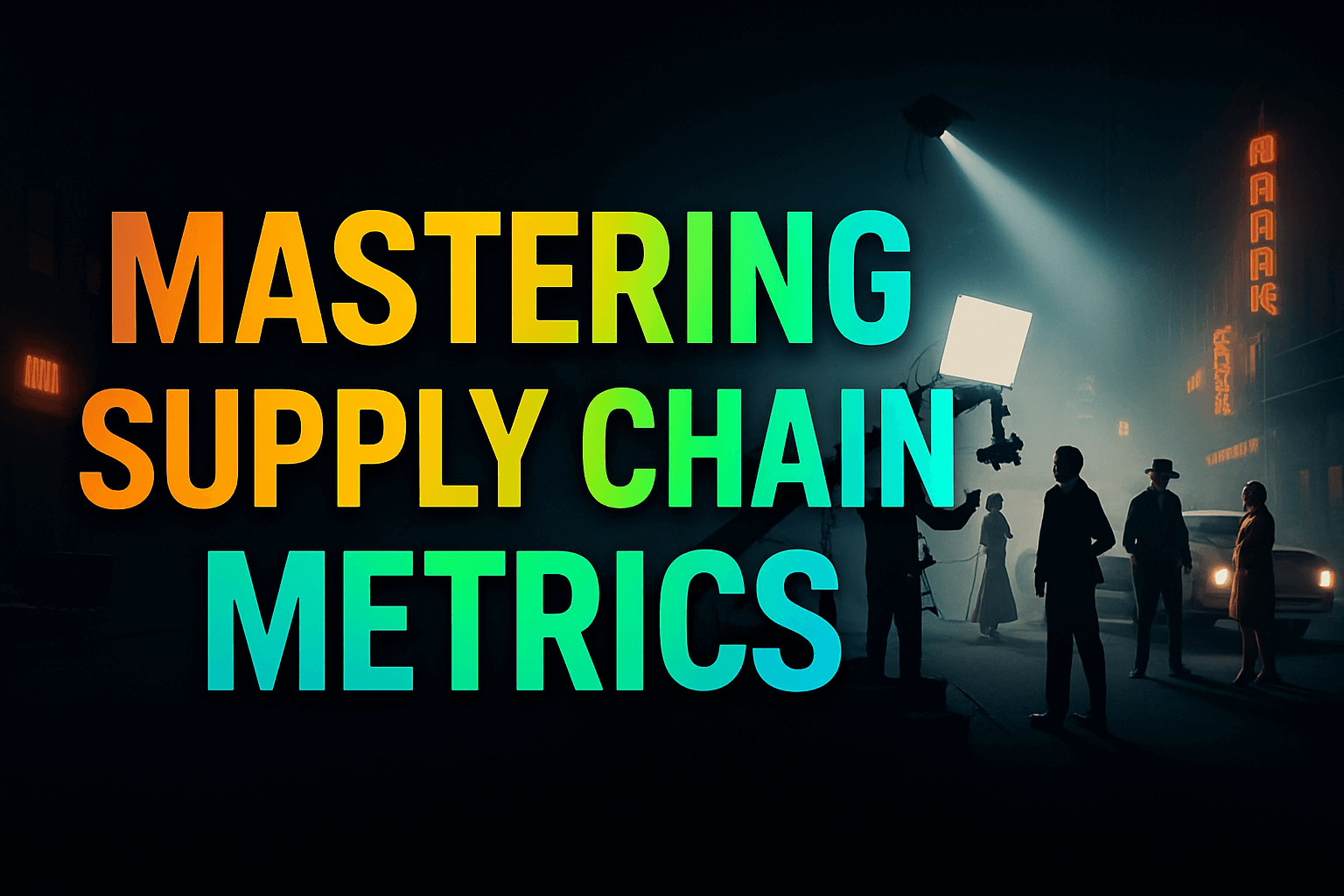Mastering Supply Chain Metrics: Entertainment Analytics for Performance Tracking

Introduction
For content strategists and operations executives, the management of the Media & Entertainment (M&E) supply chain is defined by volatility, bespoke projects, and a global network of specialized vendors.
Traditional logistics models and their supply chain metrics often fail to capture the unique, project-based nature of this industry, leading to blind spots in efficiency and immense risk in production. To achieve operational efficiency and drive strategic decisions, M&E leaders must adopt a new framework for entertainment analytics and performance tracking.
This guide outlines how to move beyond conventional measures to a system based on project velocity, partner reliability, and verified data—a shift fundamentally enabled by the global intelligence platform, Vitrina.
Table of content
- The M&E Measurement Problem: Beyond Traditional Supply Chain Metrics
- Redefining KPIs for the Content Life Cycle: Performance Tracking for Projects
- The Data Quality Challenge: The Barrier to Entertainment Analytics
- The Vitrina Solution: A Framework for Actionable Entertainment Analytics
- How Vitrina Enables Next-Generation Performance Tracking
- Conclusion: The Future of Supply Chain Management
- Frequently Asked Questions
Key Takeaways
| Core Challenge | Traditional supply chain metrics fail to measure the project-based risks (creative and financial) and partner reliability unique to the content life cycle. |
| Strategic Solution | Implement entertainment analytics that prioritize Project Velocity, Verifiable Partner Reliability, and comprehensive performance tracking across development and production. |
| Vitrina’s Role | Vitrina provides the verifiable project-level and executive data quality needed to calculate these new metrics and close the critical lack of supply chain visibility. |
The M&E Measurement Problem: Beyond Traditional Supply Chain Metrics
The media supply chain—encompassing everything from greenlight to distribution—is not a logistics problem; it is a creative procurement and production pipeline.
Applying common manufacturing supply chain metrics, such as Inventory Turnover or Freight Cost per Unit, yields meaningless results when dealing with unique creative assets. The core measurement problem for M&E is threefold:
- Project Specificity: Every film, series, or video game is a new product with a unique set of vendors, key personnel, and timelines. The content itself is the “inventory,” and its value fluctuates constantly, making metrics like Days Sales of Inventory (DSI) irrelevant.
- Fragmented Visibility: The content life cycle is globally dispersed. The VFX is in Vancouver, the sound mix is in London, and the development is in Los Angeles. This fragmentation creates a severe lack of supply chain visibility, preventing accurate performance tracking.
- Focus on Cost Over Risk: Over-reliance on simple financial metrics (like Supply Chain Cost as % of Sales) can incentivize choosing the cheapest vendor, disregarding the far greater potential cost of production delays, quality issues, and creative misalignment.
This reality necessitates a shift in focus to actionable entertainment analytics that measure execution reliability and project momentum.
Redefining KPIs for the Content Life Cycle: Performance Tracking for Projects
For senior executives, effective performance tracking means implementing supply chain metrics that measure the critical factors of the content world: speed, reliability, and cost relative to complexity.
Metric 1: Project Velocity (Time-to-Market)
Project Velocity measures the time required to move a creative asset between defined milestones in the content life cycle (e.g., greenlight to principal photography, or picture lock to final delivery).
- Calculation: (Target Completion Date – Actual Completion Date) per phase.
- Strategic Value: Allows executives to instantly identify operational bottlenecks, whether they reside in contracting, partner selection, or internal review processes. A low Project Velocity signals a systemic issue, driving an investigation into the pipeline rather than just penalizing a single team.
Metric 2: Verifiable Partner Reliability (Due Diligence)
The Perfect Order Rate (POR) is a common logistics KPI, but M&E needs a Verifiable Partner Reliability metric that bundles quality, delivery, and creative fit.
- Calculation: (Projects Delivered On-Time Projects Delivered On-Budget Projects with Verified Tier 1 Executive Team) / Total Projects.
- Strategic Value: This metric is a true project-based metric. It quantifies the risk associated with an external vendor or co-production partner. By measuring a verifiable track record of success, it moves the negotiation from anecdotal reputation to hard data, directly addressing risk associated with supplier lead time variability.
Metric 3: Supply Chain Cost as a Percentage of Project Budget
This shifts the focus from total sales to the specific project being measured, aligning the cost structure with the content’s unique financial envelope.
- Calculation: (Total External Vendor Costs + Internal Operational Costs) / Total Project Production Budget.
- Strategic Value: Provides a clean benchmark for efficiency and cost-control across different production types (e.g., scripted vs. unscripted, film vs. animation). This metric allows an executive to instantly compare the relative operational efficiency of two similar content projects.
The Data Quality Challenge: The Barrier to Entertainment Analytics
The biggest impediment to implementing these strategic supply chain metrics is the data quality gap. Effective entertainment analytics demand granular, verified data that simply does not exist in internal ERP systems or legacy databases.
- The Velocity Gap: Tracking Project Velocity requires external visibility into a partner’s current and past project load. A sound designer might look available, but they could be tied up in post-production on a competitor’s title. This lack of transparency leads to inaccurate scheduling.
- The Reliability Gap: Calculating Verifiable Partner Reliability is impossible without a centralized database that links executives, companies, and their specific past projects in a neutral, verified manner. Executives are often left to rely on self-reported data, which presents an unacceptable level of risk. The industry’s reliance on fragmented and often unverifiable data leads to missed deadlines and unexpected costs, as highlighted by multiple industry reports
The Vitrina Solution: A Framework for Actionable Entertainment Analytics
Vitrina closes the lack of supply chain visibility by providing the essential, verifiable entertainment analytics necessary to power the new generation of supply chain metrics. We transform the complex, fragmented M&E ecosystem into a measurable, data-driven environment.
Leveraging the Project Tracker for Real-Time Data
Vitrina’s Film+TV Projects Tracker addresses the Project Velocity metric head-on:
- Real-Time Milestone Tracking: The platform provides a transparent view of 100,000+ active projects globally, tracking their progress from development through post-production. This enables M&E leaders to perform real-time pipeline comparisons, providing the data points for the performance tracking required to measure Project Velocity accurately.
- Competitive Benchmarking: By seeing the project load and status of key competitors, organizations can forecast market capacity and adjust their timelines accordingly, moving beyond reactive management.
Quantifying Partner Risk with Verifiable Track Records
For the critical Verifiable Partner Reliability metric, Vitrina is the only solution that delivers the required level of data quality and verification.
- Due Diligence on Demand: The platform houses a verifiable track record for over 3 million executives and 600,000 companies, mapping specific roles and collaborations to past projects. This allows an executive to execute a rigorous due diligence protocol in minutes, calculating the true reliability of a potential partner.
- Financial & Operational Context: Users can access a company’s past co-production partners, deal types, and scale, which are crucial project-based metrics for assessing the risk and cost alignment before entering a deal.
How Vitrina Enables Next-Generation Performance Tracking
Vitrina is the intelligence layer that finally allows M&E companies to implement data-driven supply chain metrics for true performance tracking. We move the industry from tracking delivery (a simple logistic act) to tracking value and risk (a complex strategic endeavor).
Our platform provides the validated input data to achieve true operational efficiency by:
- Enabling Metric Calculation: Providing the verified external data (project status, partner history) necessary to accurately calculate key project-based metrics like Project Velocity and Verifiable Partner Reliability.
- Mitigating Talent Risk: Allowing executives to search and verify personnel by their specific roles and successes, reducing the risk of creative misalignment and budget overruns—a major component of total supply chain risk.
- Connecting the Value Chain: Showing the complete, end-to-end connections between studios, vendors, distributors, and financiers globally, which is essential for understanding the total cost and time associated with the content life cycle.
Conclusion: The Future of Supply Chain Management
The future of supply chain metrics in the M&E sector hinges on a commitment to entertainment analytics that value transparency, verification, and project-level focus.
By prioritizing metrics like Project Velocity and Verifiable Partner Reliability over generalized logistics KPIs, M&E leaders can achieve unprecedented performance tracking accuracy.
Platforms like Vitrina are indispensable tools in this transition, providing the necessary data quality to transform the opaque, reputation-driven process into a measurable, scalable, and strategically defensible operation.
Frequently Asked Questions
Key performance indicators in M&E should measure operational aspects like project velocity (time-to-market), verifiable partner reliability, and supply chain cost as a percentage of the total project budget. These are critical alongside audience and financial metrics like subscription growth and ROI.
The main challenge is the inherent information asymmetry and lack of supply chain visibility. Because M&E involves unique, project-based creative assets, it is difficult to acquire verifiable, real-time data on partner capacity, executive track records, and project status outside of internal systems.
While cash-to-cash cycle time is traditionally complex, M&E must adapt it to the project level: (Days in Development + Days in Production/Post-Production) – Days until First Revenue Received. For content, this often spans years, but tracking variance from the target is the most valuable analytic.
The widely-used SCOR model often focuses on five measures: reliability, responsiveness, agility, cost, and asset management. In M&E, these translate to partner reliability, project velocity, ability to adjust to production changes, cost relative to project, and efficient use of creative IP assets.















































